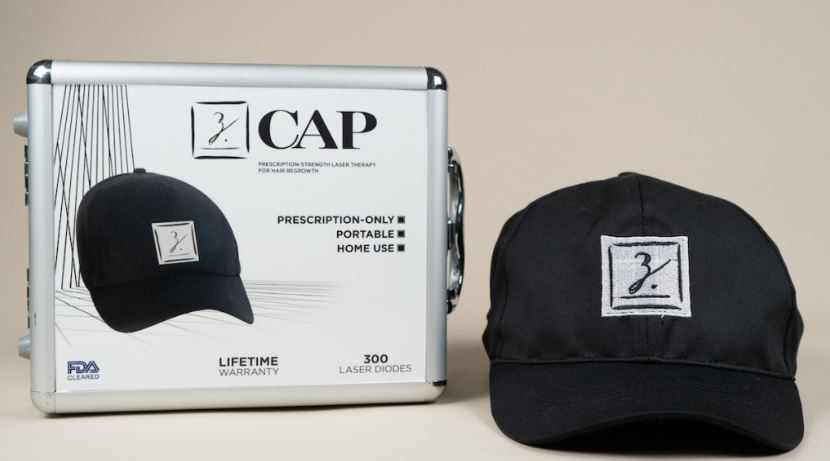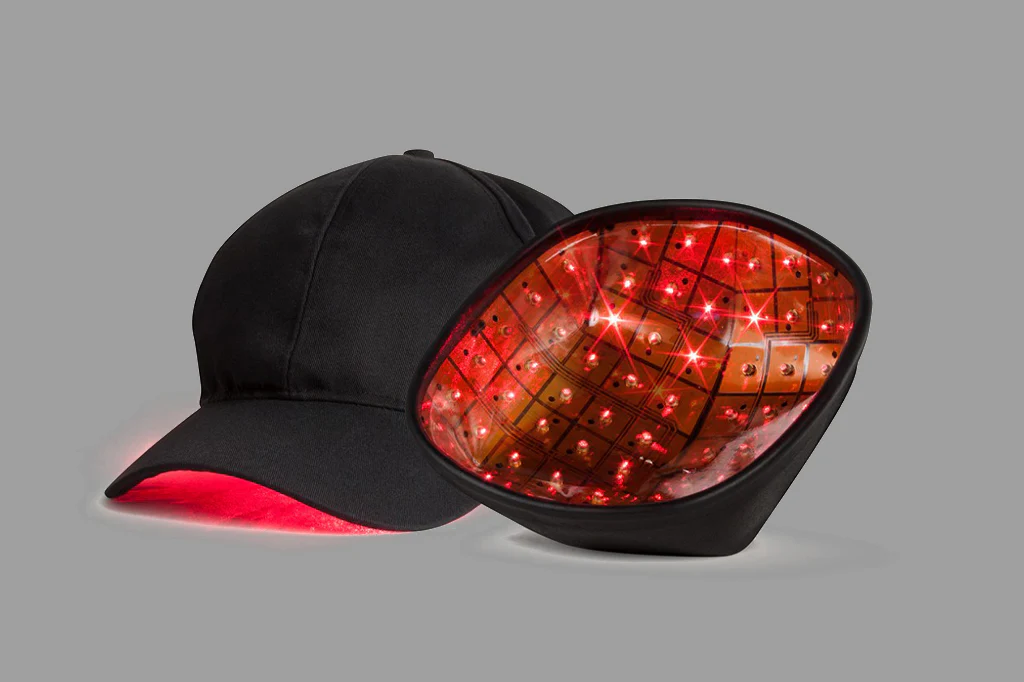Does Laser Hair Therapy Work?

Laser light therapy for hair loss has been clinically proven to improve pattern baldness in men and women. It’s completely noninvasive, safe, and requires zero downtime. It’s often used with other hair loss medications like finasteride and topicals like minoxidil and exosome therapy to further enhance hair regrowth. Laser hair therapy works best for early-stage hair thinning and as a maintenance therapy rather than a solution for advanced baldness.
What is Low-Level Laser Therapy?
Low-level laser therapy (LLLT), also called laser hair therapy or red light therapy, is a non-invasive treatment that uses low-level lasers to stimulate hair follicles and encourage hair growth. When red laser light illuminates the scalp, stem cells in the dermal papilla absorb the energy, boosting cellular respiration and enhancing their role in controlling the hair cycle and promoting growth.
LLLT is commonly used to treat androgenetic alopecia (male and female pattern baldness) and hair thinning caused by other factors like stress or medical conditions. It’s FDA-cleared, safe, and painless, making it an excellent option for those looking to improve hair density without surgery or medications.
How Does Low-Level Laser Therapy Work?
Low-level laser therapy works by using red or near-infrared light to stimulate hair follicles, improve blood circulation, and encourage new hair growth. The laser energy penetrates the scalp, reactivating weakened follicles and extending the growth phase of the hair cycle by slowing and in some cases reversing miniaturization, which is the process by which hair follicles begin to shrink as the typical hair growth phase becomes shorter and shorter. As a result, each hair cycle produces hair that is shorter and thinner than the previous cycle. Low-Level laser therapy helps slow down hair thinning and promotes thicker, healthier strands over time.
Professional In-Clinic Laser Treatments
In a clinical setting, laser therapy for hair loss is performed using high-powered laser devices that provide consistent, targeted treatment. These weekly sessions are typically overseen by a hair restoration specialist and offer a more intensive approach compared to at-home devices. Professional treatments may be recommended for patients experiencing moderate to advanced hair thinning or those looking to maximize their hair restoration results post-transplant.
At-Home Devices: The Z Cap
For patients who want the convenience of at-home treatment, the Z Cap offers a powerful solution. This medical-grade, FDA-cleared device delivers the same low-level laser therapy as in-clinic treatments but in a portable and easy-to-use design. The Z Cap fits discreetly under a regular hat, allowing users to undergo treatment anytime, anywhere.
Why Choose the Z Cap?
- Uses high-energy laser diodes (no LEDs) for maximum follicle stem cell stimulation
- Get your laser therapy hair loss treatment anytime, anywhere
- Hands-free, wireless design for easy use at home or on the go
- Designed for full scalp coverage and even light distribution
- Clinically proven to increase hair density and slow hair loss progression

Both in-clinic treatments and at-home devices like the Z Cap can be effective for hair regrowth. The key here is consistent use. Patients who commit to regular treatments typically see the best results over time.
How Well Does Laser Hair Therapy Work?
Laser hair therapy is an FDA-cleared, clinically proven treatment for hair loss, particularly hereditary hair loss, aka androgenetic alopecia. It’s been shown to increase hair density, slow hair loss, and improve overall scalp health when used consistently.
One study demonstrated that low-level laser therapy led to a 37% increase in hair growth in women with androgenetic alopecia compared to the placebo group. Another study also saw a significant increase in terminal hair density in both men and women with pattern hair loss after being treated with LLLT.
Does Laser Hair Therapy Work for Everyone?
Laser hair therapy is an effective treatment for many people, but it’s not for everyone. While it can slow hair loss and improve hair density, its success depends on the person’s hair loss stage, genetics, and consistency of use.
Laser therapy works best for individuals experiencing early-stage hair loss or thinning hair rather than those with complete baldness. It’s also commonly used post-hair transplant to support healing and hair regrowth and with other treatments like oral DHT-blockers and minoxidil as well as topical solutions like KeraFactor, ZMIN and ZFIN.
How Long Does It Take to See Results?
Results from low-level laser therapy hair treatment are gradual and it takes consistent use over time to see noticeable improvements. Patients who stick to their treatment plan typically begin to see early improvement within 3 with increasing results over the next 12 months.
Is Laser Hair Therapy Safe?
Yes, laser hair therapy is safe. It’s an FDA-cleared, non-invasive treatment that uses low-level laser light to stimulate hair growth without causing damage to the skin or scalp. Unlike surgical procedures or medications, LLLT has no serious side effects and does not involve pain, downtime, or long-term risks.
Most people tolerate laser therapy well, but some may experience mild scalp sensitivity or warmth and a temporary increase in shedding. These side effects are temporary and usually decrease after treatment. LLLT is safe for pregnant women, but it’s best to consult your doctor first before booking your treatment.
How Much Does Laser Hair Therapy Cost?
In-office laser treatments for hair loss typically cost around $200 to $500 each session. Since in-clinic laser therapy can take months to show results, and you’ll need to schedule a minimum of 3 visits per week. These costs can add up pretty quickly.
On the other hand, the Z Cap costs $3,000. While the upfront cost of a laser cap is higher, it saves money and time in the long run by reducing the need for professional treatments.
Led by celebrity surgeon Dr. Craig Ziering, the Ziering hair transplant doctors bring 75+ years of combined surgical experience and have successfully transplanted over 100 million hair grafts. Choosing Ziering Medical means choosing world-class hair restoration and unmatched patient care you won’t find elsewhere.
Call us or visit the nearest Ziering Medical clinic in your area to book a consultation. We serve patients all over the greater Tri-state area of New York, New Jersey, and Connecticut, as well as the greater Southern California area from Los Angeles and Beverly Hills to Newport Beach and San Diego.
Laser hair therapy is available at many clinics, including medspas and dermatology offices that don’t specialize in hair restoration. But not all providers are equal. For real results, go to a specialized hair restoration clinic with board-certified doctors. They understand hair loss, customize treatments, and offer additional treatments like medications and topicals if needed.
Don’t waste time on the wrong provider. For expert laser hair therapy near you, call or visit Ziering Medical to book a consultation. We serve patients all over the greater Tri-state area of New York, New Jersey, and Connecticut, as well as the greater Southern California area from Los Angeles and Beverly Hills to Newport Beach and San Diego.
Frequently Asked Questions
Can laser hair therapy regrow hair on bald spots?
LLLT works best for thinning hair and early-stage hair loss. It can rejuvenate weakened hair follicles, but it won’t regrow hair on completely bald areas where follicles are no longer active.
How often should I use laser hair therapy?
Most treatment plans recommend 3 to 4 sessions per week for best results. Consistency is key to seeing improvements in hair density and thickness.
Is laser hair therapy painful?
No, LLLT is completely painless. You may feel a mild warmth on the scalp, but there’s no discomfort or downtime.
How long does a laser therapy session take?
Most laser caps and in-clinic treatments take 30 minutes per session.
Can women use laser hair therapy?
Yes. LLLT is FDA-cleared for both men and women experiencing pattern hair loss. Many patients also report healthier hair with more shine and luster.
Can I stop using laser hair therapy once I see results?
Stopping treatment can lead to gradual hair thinning over time. For long-term results, maintenance treatments are recommended.
